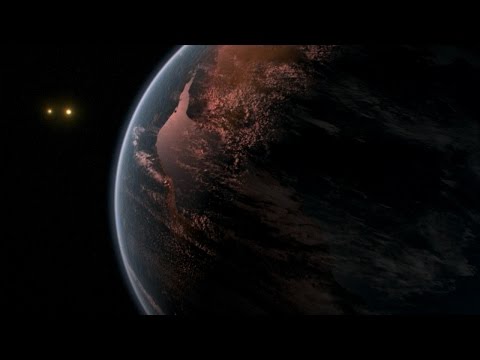There Could Have Been Life On Venus!
Was Venus once a tropical oasis?Did it once have LIFE?Well, if it did, it doesn’t any more becauseit’s a HELLHOLE. Hello fellow terrestrial lifeforms!Trace here for DNews and I want you to considerVenus. Apparently that nasty, hot and toxic worldis Earth’s “twin”, its EVIL twin. Venus is around 80% the mass of Earth. Earth and Venus have similar orbits and arelikely made of similar materials. In fact, Venus may have been once surprisinglyEarth-like!It sits on the inner edge of our solar system’shabitable zone and could have even been averitable oasis!It’s even thought that Venus could have oncehad oceans!But today Venus has an atmosphere that crusheseverything on its surface with about 90 timesmore pressure we experience here. It’s so hot that lead will melt. It’s a planet where the greenhouse effecthas gone into overdrive and probably is thelast place in the solar system you’d considerfor your next vacay. See, something catastrophic happened to theplanet’s atmosphere, causing it to turninto a swirling hot mess and, as Venus receivesaround double the solar energy of Earth, thewater content in its atmosphere was eventuallybroken down through a process called photodissociation. Today, the planet is bone dry. But again, we think it wasn’t always thisway. In the journal Geophysical Research Letters,scientists used 3-D models of Venus and simulatedhow its atmosphere would evolve if the planethad an ocean containing 10% the volume ofour oceans on Earth. What they found was that because of Venus’super slow rotation rate and the factour sun was cooler in the past, the planetwould have actually been pretty habitablefor a very long period of time — possiblyfor billions of years!This is even considering the fact that oursun got hotter as it got older. In fact, this research says Venus could havebeen a habitable world as recently as 700million years ago. 12, 13That’s not that much time. This is surprising because until now, it hadbeen assumed that Venus’ closer orbit aroundthe sun would have caused atmospheric temperaturesto soar and any oceans to boil away billionsof years ago. What they wanted to find out was how youngVenus regulated its temperature. And interestingly, to do this, researchersused the same models we use today to simulatethe effects of human-driven climate change. These models predict that water vapor formingclouds in Venus’ atmosphere would have preventedthe sun’s extreme heat from driving atmospherictemperatures too high, allowing the planetto remain very Earth-like for billions ofyears12. And when you combine habitable temperatureswith liquid water and billions of years, youget the possibility of the evolution of life!Sadly, we may never know if Venus once possessedlife, as it’s currently almost impossiblefor us to land a robot on the surface andexpect it not to melt. Though we have had landers there before, nonehave lasted for longer than a couple of hours. But this research shows that planets foundaround other stars with orbits that were onceconsidered “too hot” to be habitable,may in fact have atmospheres cool and stableenough for life to take hold. This is awesome and may increase the numberof potentially habitable worlds in our galaxy!Guys, if you love DNews in English — graciaspor tu apoyo!Now, we’ve got a new sister show, “DNews enEspañol” — It’s DNews, but in Spanish!If you like space, but want it to be moreespace: ¿Qué pasa si te traga un agujeronegro?Check it out here. Venus might sound pretty crappy for life,but we’ve found a possibly more habitableworld on our galactic doorstep — welcometo Proxima b:What do you guys think?Would you rather go to Venus or Mars?












